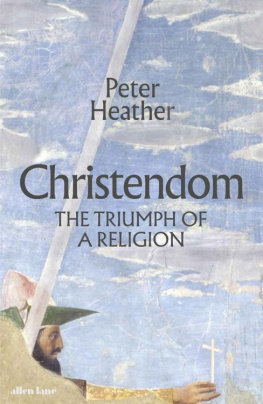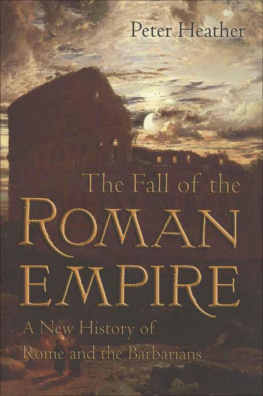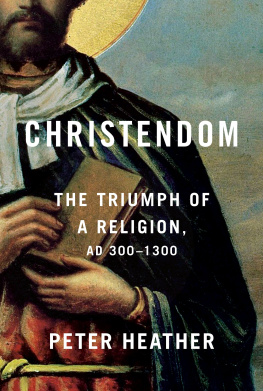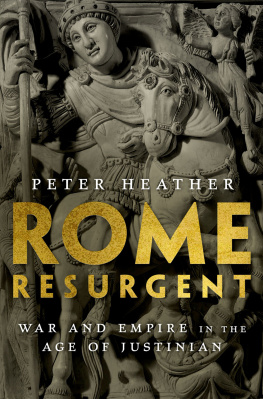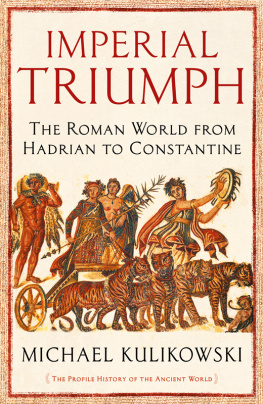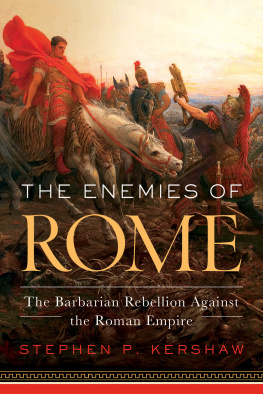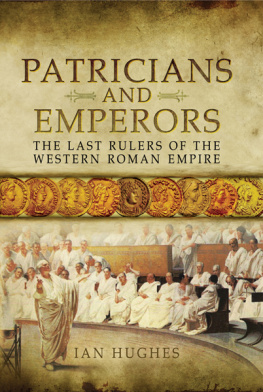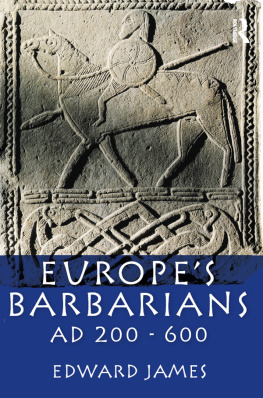THE RESTORATION OF ROME
Also by Peter Heather
THE FALL OF THE ROMAN EMPIRE
EMPIRES AND BARBARIANS
PETER HEATHER
THE RESTORATION OF ROME
Barbarian Popes & Imperial Pretenders


Oxford University Press is a department of the University of Oxford.
It furthers the Universitys objective of excellence in research,
scholarship, and education by publishing worldwide.
Oxford New York
Auckland Cape Town Dar es Salaam Hong Kong Karachi
Kuala Lumpur Madrid Melbourne Mexico City Nairobi
New Delhi Shanghai Taipei Toronto
With offices in
Argentina Austria Brazil Chile Czech Republic France Greece
Guatemala Hungary Italy Japan Poland Portugal Singapore
South Korea Switzerland Thailand Turkey Ukraine Vietnam
Oxford is a registered trade mark of
Oxford University Press in the UK and certain other countries.
Published in the United States of America by
Oxford University Press
198 Madison Avenue, New York, NY 10016
Peter Heather 2013
First published in 2013 in Great Britain by Macmillan, an imprint
of Pan Macmillan, a division of Macmillan Publishers Limited
Map artwork by ML Design
All rights reserved. No part of this publication may be reproduced,
stored in a retrieval system, or transmitted, in any form or by any means,
without the prior permission in writing of Oxford University Press,
or as expressly permitted by law, by license, or under terms agreed with the
appropriate reproduction rights organization. Inquiries concerning reproduction
outside the scope of the above should be sent to the Rights Department,
Oxford University Press, at the address above.
You must not circulate this work in any other form
and you must impose this same condition on any acquirer.
Library of Congress Cataloging-in-Publication Data
Heather, P. J. (Peter J.)
The restoration of Rome : barbarian popes and imperial
pretenders / Peter Heather.
pages cm
Includes bibliographical references and index.
ISBN 978-0-19-936851-8 (hardback)
1. EuropeHistory476-1492. 2. Theodoric, King of the Ostrogoths, 454?-526.
3. Justinian I, Emperor of the East, 483?-565. 4. Charlemagne, Emperor, 742-814.
5. Catholic ChurchHistory. I. Title.
D117.H395 2014
909.07dc23 2013047264
1 3 5 7 9 8 6 4 2
Printed in the United States of America on acid-free paper
FOR ANITA HOLM SAWYER
CONTENTS
PART ONE
A COPY OF THE ONLY EMPIRE
PART TWO
THE CONQUEROR OF MANY NATIONS
PART THREE
THE FATHER OF EUROPE
PART FOUR
SECOND COMING
ON OR ABOUT 4 SEPTEMBER 476, a senior officer of the Roman army of Italy called Odovacar arrested and executed the uncle of the reigning Western emperor Romulus, known as Augustulus: the little Augustus. Seven days before, Odovacar had done the same with Romulus father. The emperor himself was only a child and his father and uncle had been running the empire. Now in charge, Odovacar proved reasonably merciful. Romulus was despatched to live out his days on an estate in Campania. More significantly for the course of European history, Odovacar also induced the Senate of Rome to send an embassy to the East Roman emperor Zeno in Constantinople. This declared that:
there was no need of a divided rule and that one, shared emperor was sufficient for both [Eastern and Western imperial] territories.
It was soon followed by a further embassy which took to Constantinople the imperial vestments of the West, including the imperial cloak and diadem which it was treason for anyone but the emperor to wear. Although he maintained the fiction of Zenos imperial sovereignty, Odovacar had not the slightest intention in practice of allowing Constantinople to interfere in the affairs of the Italian-based state that he now ran. Odovacars two embassies brought to an end an imperial tradition based on Rome which stretched back nearly 750 years.
But Odovacars deposition of Romulus Augustulus was no more than a coup de grce. The western half of the Roman Empire had been killed off progressively over the three previous political generations, as a remarkable revolution in the balance of strategic power worked itself out across the broader European land mass. Apart from some very early successes, such as the capture of Sicily in the third century BC, the bulk of the Roman Empire had been acquired in the two centuries either side of the birth of Christ. This was an era when non-Mediterranean Europe was subdivided into three broad geographical regions west and south, north-central, and north and east each home to human societies which were operating at strikingly different levels of development. Levels of food production, population density, economic complexity, settlement size and scales of political organization: all of these were much higher in La Tene Europe to the west and south, and fell off substantially as you moved east and north through the other two zones. During this crucial 200 years of empire-building, Romes Mediterranean heartlands provided sufficient economic and demographic resources, combined with a formidable military organization, to conquer all of the European land mass which was worth conquering. In practice, only the west and south offered post-conquest receipts and sufficient spoils of war to justify large-scale campaigning, and it was on its far borders that the legions hobnails came to a halt.
Human ambition being what it is, though, efforts were also made to subdue parts of the central zone, largely dominated by Germanic-speaking populations, and it is often thought that Arminius great victory over a Roman army in the Teutoburg Forest in AD 9 put a stop to the process. Reality is more prosaic. Further Roman campaigns destroyed Arminius subsequently, and it was really the logic of an imperial cost-benefit equation which meant that Rome eventually allowed its frontier to coagulate on the river Rhine and not push it on further to the east. At the start of the first millennium, the north-central zone was not worth the costs of conquest, while outer Europe, the third zone to the north and east, never even figured on the imperial radar.
Over the next 400 years, however above all because of the kickstart provided by interaction with the Roman Empire to everything from economics to political and cultural patterns an accelerating process of development transformed patterns of life in this central zone. By the mid-fourth century AD, agricultural production had intensified, population densities increased massively, and economic patterns acquired previously unknown complexity. The military capacity of the region as a whole had also grown markedly not least through the adoption of Roman weaponry and its political structures had become much more robust. It remained impossible to build large, enduring states within the region because economic and administrative substructures could still not support complex political superstructures, so that Rome, broadly speaking, retained overall strategic control. Nonetheless, by the fourth century AD, the empire was having to run
My father was an explosives expert, who spent much of his life among dangerous substances. A fundamental safety principle he picked up early on in his training was that wherever human activity created a flammable atmosphere, God i.e. some accident or another would provide the spark. In other words, safety had to focus on preventing the build-up of flammable conditions, since trying to guard against sparks was utterly hopeless. In the case of European history, the fundamental transformation of the old north-central zone created a potentially highly flammable political situation at least as regards the long-term future of Roman imperialism and the spark eventually came along in the form of the Huns. Exploding on to the fringes of Europe in two stages in the final quarter of the fourth century, the Huns pushed two large mixed blocks of old Roman clients from the transformed north-central region (together with some other groups from much further away) on to imperial territory in two distinct clusters: the first in AD 37580, and the second a quarter of a century later in 40510. The first of these moments coincided with the Huns occupation of lands immediately north of the Black Sea, and the second, in all probability, with their further penetration westwards on to the great Hungarian Plain. In the face of (natural) Roman hostility which saw large numbers of those caught up in the movements either killed or reduced to slavery, the survivors of both immigrant blocks (and many of the original participants had fallen en route) had, by the end of the 410s, reorganized themselves into two new composite groupings on West Roman soil, which were larger and more coherent than anything that had existed on the other side of the frontier in the fourth century: the Visigothic and VandalAlan coalitions. Each was composed of at least three major, previously independent, sources of military manpower, and both had evolved more centralized leadership structures to match. They had become larger to survive in the face of Roman counter-attack, and the greater wealth of the Roman world, compared to that beyond the frontier, made it possible for new dynasties to mobilize sufficient resources to maintain themselves in power.
Next page

